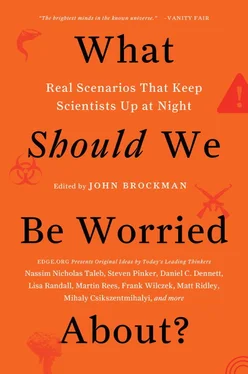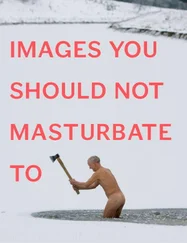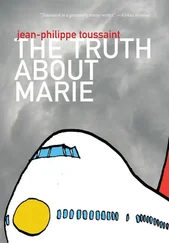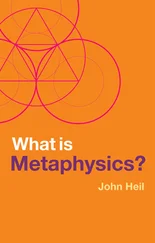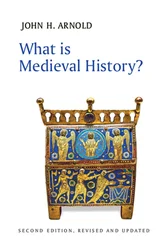These days when I stand at the doorstep with a winged apocalyptic evangelist behind me and an anoraked one before me, I feel obliged to put over a scientific view of the world, civilly, firmly, clearly. Even with optimism. After all, I am not so in thrall to Armageddon as to think that a coming intellectual Dark Age, even a global one, would last forever.
MATT RIDLEY
Science writer; founding chairman, International Centre for Life; author, The Rational Optimist
I worry about superstition. Rational optimists spend much of their energy debunking the charlatans who peddle false reasons to worry. So what worries me most are the people who make others worry about the wrong things, the people who harness the human capacity for superstition and panic to scare us into doing stupid things: banning genetically modified foods, teaching children that the Earth is 6,000 years old, preventing the education of girls, erecting barriers against immigrants or free trade, preventing fossil fuels taking the pressure off rain forests—that sort of thing.
Superstition can help bring down whole civilizations. As Rome collapsed, or in the Ming Empire, or under the Abbasid Caliphate, the triumph of faith over reason played a large part in turning relative into absolute decline in living standards. By faith, I mean argument from authority.
There is a particular reason to worry that superstition is on the rise today—a demographic reason. As Eric Kaufmann documents in his book Shall the Religious Inherit the Earth?, the fundamentalists are breeding at a faster rate than the moderates within all the main religious sects: Sunni, Shia, Jewish, Catholic, Protestant, Mormon, Amish. The differential is great and growing.
Fortunately, children do not always do what their parents tell them. Millions of indoctrinated fundamentalist children will rebel against their faith and embrace reason and liberty, especially in the age of the Internet, mobile telephony, and social networks. But there’s another demographic trend: the declining global birthrate, with the number of children per woman plummeting to two or less in more and more countries. In a world with generally high birthrates, a breeding frenzy among fundamentalists would not matter much, but in a world with low birthrates the effect could be startling. If secular folk don’t breed while superstitious ones do, the latter will soon dominate.
It’s not just religious superstition that bothers me. Scientific superstition seems to be on the rise, too, though not because of demography. Science as an institution, as opposed to a philosophy, has long had a tendency to drift toward faith—argument from authority—as well. Consider the example of eugenics in the first half of the last century, or Lysenkoism in the Soviet Union, or Freudianism, or the obsession with dietary fat that brooked no dissent in the 1970s and 1980s. Dissidents and moderates are all too often crowded out by fundamentalists when science gets political. Fortunately, science has a self-correcting tendency, because it is dispersed among different and competing centers. Dread the day when science becomes centralized.
GREGORY BENFORD
Professor of physics & astronomy, emeritus, UC Irvine; science fiction author, Anomalies
One iconic image expresses our existential condition: the pale blue dot. That photograph of Earth the Voyager 1 spacecraft took in 1990 from 6 billion kilometers away told us how small we are. What worries me is that that dot may be all we ever have, all we can command, for the indefinite future. Humanity could become like rats stuck on the skin of our spherical world, which would look more and more like a trap.
Imagine: We’ve had our burgeoning history here and used up many resources… so what happens when they run out? Valuable things like metals, rare earths, fertilizers, and the like are already running low. More things will join the list.
Voyager has flown outward for thirty-six years, a huge return on the taxpayers’ investment. It is the first probe that will leave the solar system and the farthest man-made object from Earth. Voyager is now exploring the boundary between our little system and the vast interstellar space beyond.
It can instruct us, still, about our more pressing problems, as Carl Sagan pointed out: “Think of the rivers of blood spilled by all those generals and emperors so that in glory and triumph they could become the momentary masters of a fraction of a dot.” They fought over resources we could exhaust within the next century or two. Voyager’ s perspective also suggests an answer: There’s a whole solar system out there. Sagan pondered that aspect, too: “There is nowhere else, at least in the near future, to which our species could migrate. Visit, yes. Settle, not yet.” That is still true, but the vast solar system can help us. I worry that we will miss this opportunity.
After all, great civilizations have turned away from horizons before. In the 1400s, China stopped trading and exploring in Africa and Arabia out of concern that this introduced unsettling elements into their society. Their nine-masted ships were 100 meters long and carried animals like giraffes back to China to amuse the emperor. China could have found America and ruled the oceans, but it chose to stay home.
We may be entering a similar age. This century will doubtless see our population rise from its current 7 billion souls to 9 or 10 billion. Climate change will wrack economies and nations. The bulk of humanity has large economic ambitions that will strain our world to satisfy. With the United States imitating Europe in its evolution into an entitlement state, it will have less energy to maintain world order. Amid constant demands for more metals, energy, food, and all the rest, it seems clear that we can expect conflicts among those who would become “momentary masters of a fraction of a dot.”
But we see in our skies the resources that can aid the bulk of humanity. With entrepreneurs now pulsing with energy, we have plausible horizons and solutions visible. SpaceX (Space Exploration Technologies Corporation), founded by former PayPal entrepreneur Elon Musk, now delivers cargo to the International Space Station. SpaceX became the first private company to successfully launch and return a spacecraft from orbit, on December 8, 2010, and Musk remarked on his larger agenda, the economic opening of space, “We need to figure out how to have the things we love, and not destroy the world.” The black expanse over our heads promise places where our industries can use resource extraction, zero-gravity manufacturing, better communications, perhaps even energy harvested in great solar farms and sent down to Earth. Companies are already planning to do so: Bigelow Aerospace (orbital hotels), Virgin Galactic (low Earth orbit tourism), Orbital Technologies (a commercial manufacturing space station), and Planetary Resources, whose goal is to develop a robotic asteroid mining industry.
Barely visible now is an agenda we can carry out in this century to avoid calamity, those rivers of blood and anguished need. We Americans especially know from history how to open new territory. Historically, coal and the railroads enabled much of the Industrial Revolution. Both came from the underlying innovation of steam engines. Coal was the new wonder fuel, far better than wood though harder to extract, and it made continental-scale economies possible. Synergistically, coal drove trains that in turn carried crops, crowds, and much else.
A similar synergy may operate to open the coming interplanetary economy, this time wedding nuclear rockets and robotics. These could operate together, robot teams carried by nuclear rockets to far places—and usually without humans, who would compromise efficiency. Mining and transport have expanded the raw materials available to humanity, and the rocket/robot synergy could do so again. As such fundamentals develop in space, other businesses can arise on this base, including robotic satellite repair/maintenance in high orbits, mining of helium-3 on the moon, and metal mining of asteroids. Finally, perhaps snagging comets for volatiles in the outer solar system will enable human habitats to emerge in hollowed-out asteroids and on Mars and beyond.
Читать дальше
